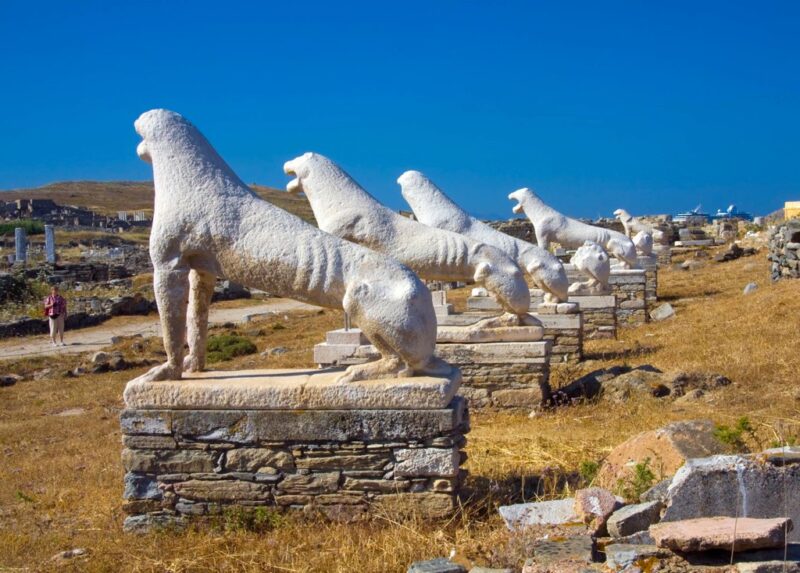This famous stadium is known by many names: the stadium of the Panathenaeus or Panathenaic stadium (Panathinaïkó stádio in Greek which means “stadium of all the Athenians”). Commonly called “marble stadium” or “Kallimármaro“ (meaning “of a beautiful marble” in Greek), it proudly bears a history that began over 2,500 years ago.
We recommend a visit to this site because it projects us easily in the ancient times thanks to its perfect state of conservation. It has kept its original vocation while being widely anchored in the modern world with the holding of major sporting and cultural events.
Practical information
Where is the Panathenaic Stadium located?
The marble or Panathenaic stadium is located along Vasileos Konstantinou avenue, in the Pangrati district (Google Maps). It can be reached by metro via line 3 (blue) at Syntagma or Evangelismos.
It’s a site I regularly take my family and friends to when visiting Athens. After watching the changing of the evzones, the presidential guard, in front of Parliament in Syntagma Square, I take them to the National Garden for a moment in the green, which we cross to reach the marble stadium.
Opening hours
- March to October: Daily 8am – 7pm
- November to February: Daily 8am – 5pm
Check on the official website.
Admission
- Full price 10€
- Reduced rate 5€
- Free for children under 6, disabled visitors and the person accompaying them
There’s even an audioguide included in the admission price, which is multilingual and rather interesting.
Origin of the Panathenaic stadium
The original stadium dates back to the 4th century B.C. It was built on the hill of Ardettos, outside the city walls. The place was inaugurated in 330 BC on the occasion of the great Panathenaeums. They were then religious and social festivals that took place in Athens. All the Athenians gathered to watch boxing, wrestling, pentathlon and chariot races. Poetry and music competitions were also held.
The stadium evolved during the Roman period. Indeed, under the impetus and contribution of Herod Atticus, major works were undertaken in the stadium between 139 and 144 BC. J.C. First of all, two curves were added to the straight track of the stadium on both sides, thus creating a circular track. The other major change is the wooden bleachers. They were entirely covered with white marble coming from the quarries of Pentele, a mountain of Attica. Statues and ornaments have been added to give the place more presence. The stadium was one of the largest and most impressive in the world.
However, with the arrival of Christianity and the abandonment of pagan rituals and bloody gladiatorial combat, the stadium was gradually abandoned. The marble was then reused in the construction of beautiful Athenian houses. The vaulted passage remained nevertheless a place of rituals where young girls went to find a good husband.

Rebirth of the Panathenaic Stadium
The revival of the Kallimarmaro stadium is due to the excavations started in 1836 and continued by Ernst Ziller in 1869. The shape of the stadium of Herod Atticus has been found. Then reconstruction works were undertaken with the help of the architect Anastasis Metaxas. It was the occasion for the stadium to host again Panathenaeums in 1870 and 1875.
Thereafter, Pierre de Coubertin, with the help of Demetrios Vikelas, succeeded in convincing the nations to hold the first modern Olympic Games in 1896 in Athens. A part of the events took place in the marble stadium. In 2004, Athens once again hosted the Olympic Games, renewing once again the age-old tradition.
The Panathenaic Stadium today
Kallimarmaro is always the setting for cultural and cultural and sporting events. It can hold up to 70,000 people. The most important event is undoubtedly the arrival of the Marathon, which takes place every year in November.
Kallimarmaro can be visited all year round. The system of audio-guide and the grandiose aspect of the place allow to spend a very good moment of history. The children particularly appreciate racing on this mythical track, at the end of which they can stand on the podium. They become, for a moment, real athletes and imagine themselves participating in the Olympic Games.
If you want to visit the Panathenaic stadium in an original way, book this fun tour and immerse yourself in the sneakers of an Olympic athlete with local agency Alternative Athens: Olympic Games Workout.
No coffee break possible in the stadium! A truck outside offers some drinks and snacks but the environment is not very pleasant. Instead, opt for the national garden located just opposite. Much nicer, it will allow you to have a little freshness. The Kafeneio is located along Irodou Attikou. You can also go to the Odeon (Mark. Mousourou 19, Athina 116 36), a small neighborhood cafe located five minutes away on foot, where you can have a drink.
If you want to know more about the Olympic Games, we also recommend the Athens Olympic Museum located in the Golden Hall in Maroussi.
Enjoy your visit!
Sophie B.
Contact Panathenaic stadium : Tel +30 210 752 2984 / Mail : info@panathenaicstadium.gr / Web site
Updated March 15, 2024




